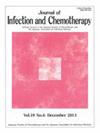Exploring the correlation between time to positivity and positive culture bottle count in Staphylococcus aureus bacteremia: Implications for metastatic lesion development
IF 1.5
4区 医学
Q3 INFECTIOUS DISEASES
引用次数: 0
Abstract
Background
The correlations between time to positivity (TTP) in blood cultures, the number of positive bottles, and their associations with mortality rates and metastatic lesion formation in Staphylococcus aureus (S. aureus) bacteremia remain unclear. This study aimed to evaluate the impact of these factors on the severity, mortality, and frequency of metastatic lesions.
Patients and methods
We retrospectively analyzed patients with S. aureus bacteremia who were admitted to our facility.
Results
A total of 317 patients were included in this study, with an average age of 70.3 years (standard deviation [SD]: 17.0); 62.5 % were male, and 22.4 % of cases involved methicillin-resistant Staphylococcus aureus infections. The average TTP was 19.9 h (SD: 11.9). No significant differences were observed in mortality or severity with respect to TTP or number of positive bottles. Further investigation into the relationship with metastatic lesions revealed that the TTP for patients with intravascular infections was significantly shorter, averaging 16.81 h (SD: 5.68), compared to 23.45 h (SD: 13.84) in patients with bacteremia. The TTP for bone and joint infections was significantly shorter, averaging 17.88 h (SD: 8.26). A weak correlation was observed between TTP and the number of metastatic lesions (r = 0.203). Additionally, a weak correlation was found between TTP and the number of positive bottles (r = 0.544).
Conclusion
TTP and bottle count did not predict the severity or mortality of S. aureus bacteremia in our study. However, positivity with a shorter TTP, particularly around or below 20 h, warrants further evaluation for intravascular and bone infections.
探讨金黄色葡萄球菌菌血症的阳性时间和阳性培养瓶计数之间的关系:对转移性病变发展的影响
背景:血培养时间到阳性(TTP)、阳性瓶数及其与金黄色葡萄球菌(S. aureus)菌血症死亡率和转移性病变形成之间的相关性尚不清楚。本研究旨在评估这些因素对转移性病变的严重程度、死亡率和频率的影响。患者和方法回顾性分析我院收治的金黄色葡萄球菌菌血症患者。结果本研究共纳入317例患者,平均年龄70.3岁(标准差[SD]: 17.0);62.5%为男性,22.4%为耐甲氧西林金黄色葡萄球菌感染。平均TTP为19.9 h (SD: 11.9)。在TTP的死亡率或严重程度或阳性瓶数方面没有观察到显著差异。进一步研究与转移灶的关系显示,血管内感染患者的TTP明显较短,平均为16.81 h (SD: 5.68),而菌血症患者的TTP为23.45 h (SD: 13.84)。骨关节感染的TTP明显较短,平均为17.88 h (SD: 8.26)。TTP与转移灶数量呈弱相关(r = 0.203)。此外,TTP与阳性瓶数之间存在弱相关性(r = 0.544)。结论ttp和瓶数不能预测金黄色葡萄球菌菌血症的严重程度和死亡率。然而,TTP较短的阳性,特别是在20小时左右或以下,需要进一步评估血管内和骨感染。
本文章由计算机程序翻译,如有差异,请以英文原文为准。
求助全文
约1分钟内获得全文
求助全文
来源期刊

Journal of Infection and Chemotherapy
INFECTIOUS DISEASES-PHARMACOLOGY & PHARMACY
CiteScore
4.10
自引率
4.50%
发文量
303
审稿时长
47 days
期刊介绍:
The Journal of Infection and Chemotherapy (JIC) — official journal of the Japanese Society of Chemotherapy and The Japanese Association for Infectious Diseases — welcomes original papers, laboratory or clinical, as well as case reports, notes, committee reports, surveillance and guidelines from all parts of the world on all aspects of chemotherapy, covering the pathogenesis, diagnosis, treatment, and control of infection, including treatment with anticancer drugs. Experimental studies on animal models and pharmacokinetics, and reports on epidemiology and clinical trials are particularly welcome.
 求助内容:
求助内容: 应助结果提醒方式:
应助结果提醒方式:


